APSC 4464 Test 1
1/111
There's no tags or description
Looks like no tags are added yet.
Name | Mastery | Learn | Test | Matching | Spaced |
|---|
No study sessions yet.
112 Terms
routes of enteral administration
in food, in water, by mouth, by oral gavage
direct oral dosing
requires restraint - may be stressful to animal; if liquid is unpalatable, may be rejected/spit out, poses risk of aspiration into trachea and lungs
routes of parenteral administration
dermal/topical, inhalation, injections
injection types
IM, SC, IP, IV, intracardiac, intranasal
steps in performing oral gavage in rodents
measure from corner of mouth to last rib for proper length/depth of insertion, restrain the animal, using needle push back on hard palate to rock head back so that passage is straight, ensure that maximum recommended volume not exceeded
variables/concerns related to whole-body inhalation versus nose-only exposure
whole body: besides being inhaled, also deposits on fur and skin, and can then be ingested orally – thus greater dose than originally calculated; nose only: limits to just inhaled dose
use of a luer-lock syringe over a standard syringe
with thick liquids, pressure may build when pushing plunger, and needle may shoot off; with a luer-lock syringe, the needle is screwed on and won’t fly off
standard convention for identifying needle diameter
lower number, larger guage (diameter); higher number, smaller guage
standard needle sizes
rodents: 23-27 guage; rabbits: 23 guage
re-using needles
tissue trauma, contamination, pain
why commercially manufactured (USP) drugs are better than non-pharmaceutical grade agents
purity, sterility, acid-base balance, longer storage/shelf life, absence of pyrogens (produced by bacterial contaminants)
common injection sites in rodents
IM (thigh muscles of hind limbs), SC (over the back), IP (ventral abdomen - near midline of upper portion of lower two quadrants), IV (lateral tail veins of rats and mice)
common injection sites in rabbits
IM (thigh muscles of hind limbs; epaxial muscles which parallel the spine), IP (ventral abdomen), SC (over the back), IV (marginal ear vein)
oral gavage and intubation maximum volume
5-20 mL/kg
mouse IM injection (mL)
< 0.05
hamster IM injection (mL)
< 0.1
rat IM injection (mL)
< 0.3
mice SC injection (mL)
< 1
rats SC injection (mL)
< 2
mice IP injection (mL)
< 1.5
rats IP injection (mL)
< 3
mice IV injection (mL)
< 0.15
rats IV injection (mL)
< 1
rabbits IM injection (mL)
< 0.5
safe blood collection volume for mice
< 0.3 mL
safe blood collection volume for rats
< 3 mL
safe blood collection volume for hamsters
< 1 mL
safe blood collection volume for rabbits
< 30 mL
what to do if larger volume of serum is requires to conduct the assay/test?
single animal - inadequate volume; terminal bleed - requires more animals, can’t follow progression over time; several animals, pooled sample, adequate volume, can follow animals over time
promoting vasodilation temperature
95-104 degrees F
promoting vasodilation in rat and mouse tail veins and rabbit ear veins
position thumb and forefinger on either side of tail or ear, apply gentle but firm pressure, use a stroking/milking motion over the vessel, starting at base and moving toward tip of tail or ear, repeat several times
subcutaneous injection cause of hypothermia
large volumes at room temperature may cause hypothermia
why the use of a vacutainer for blood collection in rodents may not be successful
collapses vessel, prevents collection of blood
location of the common vessels used for blood collection
tail, ear, face, eye, front legs, hind legs
lateral tail veins
mice and rats
marginal ear vein, central artery
rabbits
accessing marginal ear vein
pluck fur from ear or apply a warming pad or administer acepromazine or apply EMLA cream, use a 20-23 guage needle, apply pressure to the vessel near the base of the ear, insert needle bevel up, as material is injected the vessel will clear and then refill with blood
submandibular and facial veins
mice and rats
retro-orbital sinus (anesthesia required)
mice, rats, hamsters
cephalic vein
rabbits
accessing cephalic vein
crosses over the forearm, wet fur with alcohol or clip fur, apply pressure over vein near elbow, insert needle bevel up in a direction from the paw to the body, aspirate to confirm correct placement, use recommended IV injection volume
lateral and medial saphenous veins
mice, rats, hamsters, gerbils
accessing lateral saphenous vein
clip hair, swap with alcohol, put pressure above the insertion site to dilate the vessel, insert needle in the direction towards the body
metatarsal vein
gerbils, guinea pigs
methods for promoting vasodilation to facilitate blood collection
warm the whole animal or the area where blood will be collected - heating pad, heat lamp, warm water in glove, dipping tail in warm water
maximum IV injection volume (single bolus)
< 5 mL/kg
maximum IV continuous infusion volume
< 2-4 mL/kg/hour
subcutaneous injection port
requires anesthesia & surgery to implant, catheter in jugular or femoral vein, same constraints on infusion volume
chronic exteriorized IV catheter
requires anesthesia & surgery to implant, catheter in jugular or femoral vein, same constraints on infusion volume, self administration (drug abuse, psychiatric drugs, pain medication)
implantable osmotic pump
implanted subcutaneously, controlled release of drug over several days or weeks
intracerebral/intraventricular injection
direct one time injection into the brain, direct delivery to the brain avoids the blood-brain barrier
why indwelling catheter maintenance is required
to maintain sterility and prevent contamination; to prevent clot (thrombus) formation; to prevent the release of emboli
steps taken to prevent thrombus formation
after administration or blood collection, use a “heparin lock” solution to prevent clot formation
proper surgical scrub procedures practiced at the site of the skin incision
three alternating scrubs of betadyne solution and alcohol, start at center and spiral outward with scrub
laparotomy
clip site, surgical scrub, incise skin with scalpel (not scissors), use rat-tooth forceps to handle skin and abdominal muscles (less trauma, less crushing of tissues), elevate abominal muscles, cut along linea alba to open abdomen (elevation needed to avoid cutting abdominal organs)
thoracotomy
insert endotracheal tube, clip site, surgical scrub, incise skin with scalpel, use rat-tooth forceps to handle skin and intercostal muscles, cut intercostal muscles (between ribs), loss of negative pressure in chest cavity results in collapse of the lungs - need to manually inflate lungs or use a mechanical ventilator
appropriate use of surgical instruments for skin and muscles
use rat-tooth forceps to prevent excessive crushing of cells; use scalpel as cut causes less trauma to cells; scissors crush cells/tissue and delays healing; hemostats are used for blunt dissection of subcutaneous tissues and for clamping off bleeding vessels
swedged vs non-swedged needles
swedged needles have the suture contained within the end of the needle - does not stick out beyond cross-section of needle, less drag, less trauma to tissues; non-swedged needles have eyelet and suture must be looped though/round it and thus has a wider diameter than the needle itself allowing dragging/friction/trauma to the tissues delaying healing
when taper point needles should be used
for hollow organs, as cutting needles would allow for suture to tear through the tissue
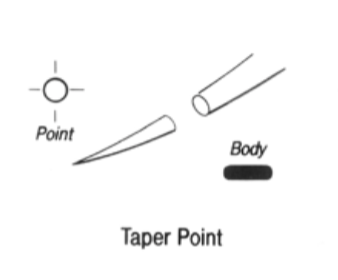
when cutting point needles should be used
for skin, to facilitate passage of the needle though the denser tissue
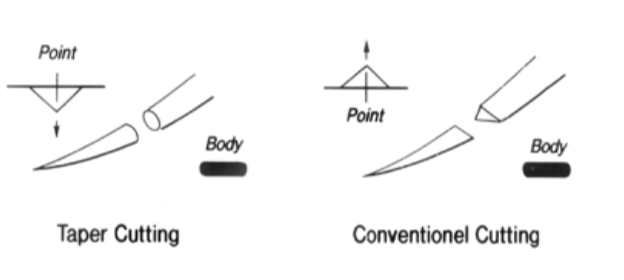
why is perfect apposition of the wound margin appropriate
perfect apposition allows faster healing with minimal scar tissue formation; eversion or inversion of the wound margin results in scarring - scar tissue is not as strong as normal tissue
which tissues have greater or lesser tensile strength
skin > muscle fascia > muscle > subcutaneous fat
closing the body wall
the peritoneum and muscle fascia provide the strongest layers for retention of sutures, in rodents - 2 layer closure is sufficient - the peritoneum and muscle fascia are sutured as one layer - the skin is sutured as a seperate layer, dogs and larger species - a 3 layer closure is needed
ideal criteria for suture material
absolute sterility, uniformity of small size, high tensile (breaking) strength, complete and measured absorbability, economy, nonreactivity in vivo, pliability and handling qualities, nonslippage of knots, monofilament composition
general problems for suture material
tensile strength in vivo often not known; sutures are often selected for their mechanical properties, without consideration of the biological interaction of suture materials and tissues
simple interrupted
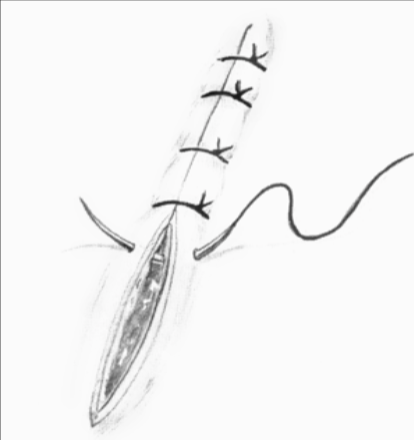
horizontal mattress
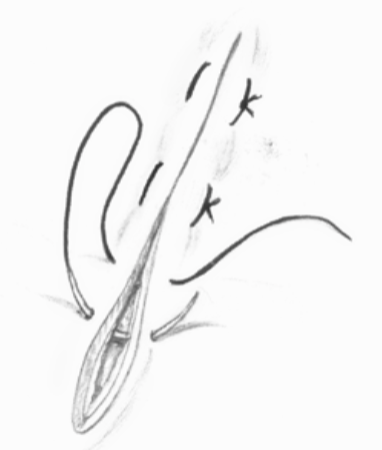
vertical mattress
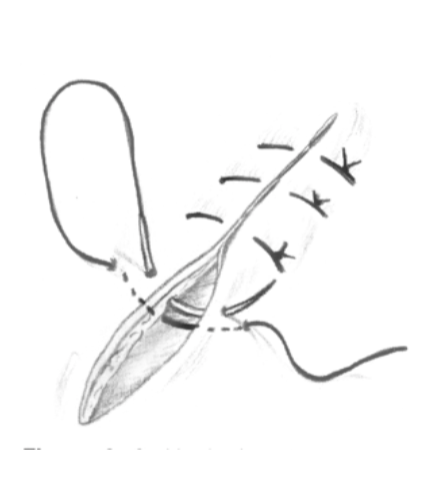
simple continuous
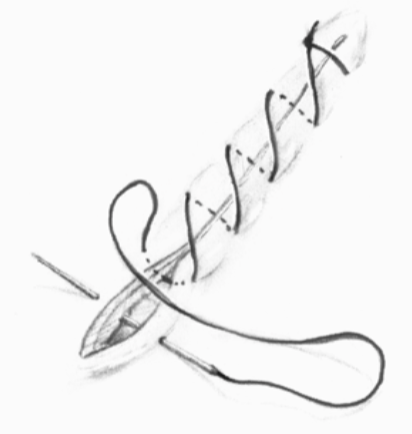
continuous interlocking
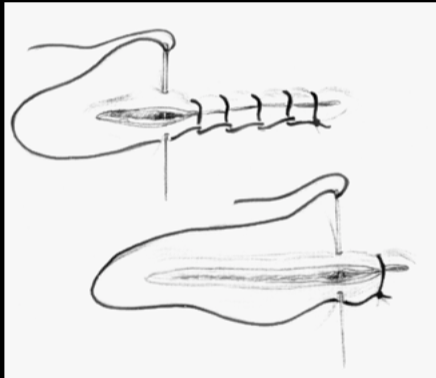
simple interrupted advantages
good apposition of the margins, loss of one suture has minimal effect
simple interrupted disadvantages
takes a little longer to do than continuous suture patterns, may tear through tissue when tension present
horizontal mattress advantages
good for areas where tension tries to pull the margins apart, loss of one suture has minimal effect
horizontal mattress disadvantages
takes a little longer to do than continuous suture patterns, causes eversion of the margins, may “strangulate” blood flow and affect healing
vertical mattress advantages
good for areas where tension tries to pull the margins apart, loss of one suture has minimal effect, not as likely to restrict blood flow
vertical mattress disadvantages
takes a little longer to do than continuous suture patterns, cause eversion of the margins
simple continuous advantages
very fast to complete, fair apposition of the margins
simple continuous disadvantages
may tear through tissue when tension present or will break, breaking of suture allows entire wound to gape open
continuous interlocking advantages
very fast to complete, fair apposition of the margins, good for tension relief
continuous interlocking suture pattern disadvantages
breaking of suture allows entire wound to gape open
absorbable suture animal origin
derived from animal tissues - catgut (collagen, surgical gut, fascial strips); PGA (woven fibers, loses strength more rapidly than catgut); wicking - capillary action
nonabsorbable sutures
resist degradation by the body (metal, natural origin - silk, cotton, synthetic material - nylon, braided polyester polyethilene)
types of anesthetic methods
local, regional, general
general anesthesia
loss of consciousness and loss of sensation
analgesia
relief from pain
narcosis
seldom asleep, but is sedated and oblivious to pain
local anesthesia
loss of sensation (pain or otherwise) in a limited body area
regional anesthesia
loss of sensation over a larger area
factors affecting anesthesia
size, age, gender, recent feeding (increases BMR), fear and activity (increases BMR - sedate initially), tranquilizers (lowers BMR), concurrent disease (can increase or decrease BMR), hepatic microsomal enzyme activity, buildup of tolerance, interaction with other drugs
factors that affect metabolic rate
smaller animals have higher metabolic rates - need larger dose per body weight, neonates have low BMR, male BMR > female BMR
methods of anesthetic delivery
dermal/topical, injectable (IM, IV, IP, SC), inhalant
two body systems affected by “anesthetic emergencies”
cardiac, respiratory
four stages of anesthesia and the appropriate plane of anesthesia
stage 1 - rising pain threshold; stage 2 - excitement phase; stage 3 - surgical anesthesia - plane 3 (appropriate plane of anesthesia); stage 4 - respiratory paralysis
four methods for assessing adequate anesthesia/analgesia
jaw tone; swallowing reflex, withdrawal reflex (toe pinch), palpebral (eyelid), corneal reflex DISCRIBE
four criteria for selection of an ideal euthanasia method/agent
rapid death without signs of pain, panic, distress, minimum time to loss of consciousness; reliable, reproducible; number of animals to be euthanized, safety to personnel; minimum undesirable physiologic effects; minimal environmental impact; simple easy to use equipment
variables which are easily recognized and controlled
diet, environmental temperature, humidity, ventilation, light cycle, water, noise
variables which are difficult to recognize and control
animal genetics, latent disease, environmental contaminants, microbial transmission, subtle behavioral stressors, idiosyncratic reactions
physical factors that affect animal research
humidity, temperature, ventilation, noise, light
diseases caused by humidity
high humidity - heat stroke, reduces resistance to infection; low humidity - ringtail in rats and mice, increased dust accumulation, affects mucociliary escalator in lungs - with low humidity, the mucus layer dries up and the cilia stop moving
diseases caused by tempurature
heat stroke or chilling, can be affected by animal activity and number of animals in housing